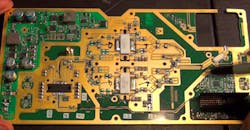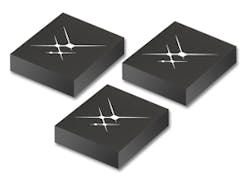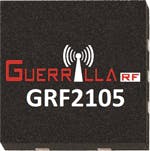Amplifiers Heighten Performance to Satisfy the Next Wave
This file type includes high resolution graphics and schematics when applicable.
The pressing needs of today’s applications are prompting amplifier suppliers to deliver new products to meet current high-frequency demands. One specific area that is now driving a significant amount of product development is small-cell infrastructure, which is a growing market. As many are turning to small cells to drive wireless networks, amplifier suppliers are launching new products in support of this need.
Small-cell infrastructure is certainly not the only area that suppliers must address. Applications demanding wideband frequency performance have prompted the launch of several new broadband amplifiers. Such amplifiers can enable both commercial and military applications that require broadband performance.
Amplifiers for Small Cells
Small cells function as miniature base stations, enabling wireless capacity to be enhanced. They can be utilized in both indoor and outdoor locations to meet wireless traffic demands. Of course, small-cell infrastructure requires the proper components, such as amplifiers.
One company supporting the fast growing small-cell market is Skyworks. “As mobile devices and applications supporting the Internet of Things (IoT) proliferate, there is an immediate and substantial increase in network load,” says David Stasey, the company’s vice president and general manager of diversified analog solutions. “An unprecedented deployment of small-cell systems is helping improve network performance.”
Skyworks recently introduced the SKY66184-11, SKY66185-11, and SKY66186-11 power amplifiers (PAs) for small-cell infrastructure (Fig. 1). “Our newest amplifiers provide infrastructure original equipment manufacturers (OEMs) with an entire portfolio of solutions for next-generation global cellular networks that cover all major LTE bands,” continues Stasey. “These amplifiers are compact devices designed for FDD/TDD small-cell base stations, enabling small-cell infrastructure OEMs to radically simplify their system architecture.
“These solutions feature high gain and linearity, along with the capability to operate under high temperatures (+85°C),” he adds. “The amplifiers are also pin-to-pin compatible, providing support of all 3rd Generation Partnership Program (3GPP) bands. Their superior output return loss makes them easy to use. An integrated coupler for output-power monitoring minimizes the number of external components required. Furthermore, the amplifiers operate off a single +3.3-V power supply.”
The SKY66184-11 operates from 2,110 to 2,170 MHz, covering LTE bands 1, 4, and 10. The SKY66185-11 spans 851 to 894 MHz, which covers LTE bands 5, 6, 18, 19, 26, and 27. The SKY66186-11, which covers a frequency range of 728 to 768 MHz, is intended for LTE bands 12, 13, 14, and 17. In addition, active biasing circuitry is integrated in these PAs to compensate performance over temperature, voltage, and process variation. Each device can provide +23 dBm of output power with an adjacent-channel leakage ratio (ACLR) of -50 dBc at +85°C.
Other companies that are enabling small-cell infrastructure include Qorvo, which recently announced a new line of PAs that target small-cell base stations. The product line contains eight new PAs, covering frequencies that altogether range from 1,805 to 2,400 MHz. The TQP9218 and TQP9418 PAs both operate from 1,805 to 1,880 MHz. A frequency range of 1,930 to 1,990 MHz is covered by the QPA9219 and QPA9419 PAs (the QPA9219’s datasheet specifies a frequency range of 1,930 to 1,995 MHz).
Furthermore, the TQP9221 PA spans 2,010 to 2,200 MHz, while the TQP9421 PA covers 2,110 to 2,170 MHz. Finally, the TQP9224 and TQP9424 PAs both operate from 2,300 to 2,400 MHz. The TQP9218, QPA9219, TQP9221, and TQP9224 PAs are rated as 0.25-W amplifiers, while the TQP9418, QPA9419, TQP9421, and TQP9424 PAs are specified to deliver 0.5 W of output power.
PAs are obviously not the only components required for small-cell infrastructure: Low-noise amplifiers (LNAs) are crucial components as well. One recently introduced product is the GRF2105 LNA (Fig. 2) from Guerrilla RF. With its broadband performance, the GRF2105 is targeted at the small-cell market. This LNA, which is housed in a 1.5- × 1.5- × 0.5-mm, 6-pin dual-flat-no-lead (DFN) package, delivers greater than 20.5 dB of gain at frequencies as high as 2,700 MHz and approximately 19 dB of gain at 3.8 GHz. Furthermore, the GRF2105 has a noise figure below 0.8 dB at 2,500 MHz.
Broadband Performance
Recently, several broadband amplifiers have been unveiled to satisfy wideband frequency requirements. One company focused on delivering broadband performance is Custom MMIC. “With new and ever-increasing demands of the internet and multimedia on the commercial side, as well as broadband high-data-rate communications and electronic-warfare (EW) links on the aerospace and military side, RF/microwave amplifiers are being used in many broadband applications,” says Jim Moniz, a principal engineer at the firm. “We have developed multiple wideband BroadRange distributed amplifiers, covering dc to 22 GHz with a unique positive gain slope.”
Moniz adds, “Unlike most distributed amplifiers, our amplifiers—such as the CMD192, CMD240, and CMD241—have positive gain slope with increasing frequency. This performance compensates for the higher-frequency losses that are typical of other components in a system. In addition to the positive gain slope, these designs include the use of on-chip tracking circuits to ensure consistent performance over temperature and process variation.”
System designers can greatly benefit from the positive gain slope provided by these amplifiers, as it allows components (such as gain equalizers) to be removed from the overall system design. Moniz explains, “The positive gain slope of the amplifier allows broadband system designers to eliminate equalizers or added amplifiers, which are used to compensate for the typical negative gain slope of most wideband components with increasing frequency.”
The recently launched broadband amplifiers from Custom MMIC include the aforementioned CMD240 and CMD241 BroadRange models. The CMD240 operates from dc to 22 GHz, while the CMD241 spans 2 to 22 GHz. The CMD238 wideband amplifier, which covers 2 to 20 GHz, was also recently unveiled.
Finally, among the latest products from Mini-Circuits is the LVA-123+ wideband amplifier, which covers a frequency range of 0.01 to 12 GHz. Delivering 17.3 dB of gain at 2 GHz, the LVA-123+ has a gain flatness of only ±0.6 dB from 0.05 to 6 GHz. The amplifier is well suited for a number of applications, including base-station infrastructure, test instrumentation, satellite-communications (SATCOM), and more.
To summarize, one can see that small-cell infrastructure will continue to be a focal point in the days ahead. And broadband requirements are driving suppliers to offer amplifiers with wideband performance. These and many other requirements will surely keep companies busy for quite some time.
This file type includes high resolution graphics and schematics when applicable.




